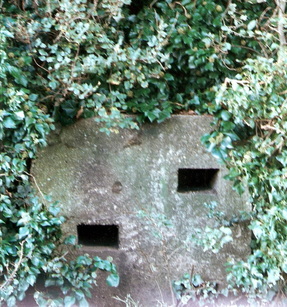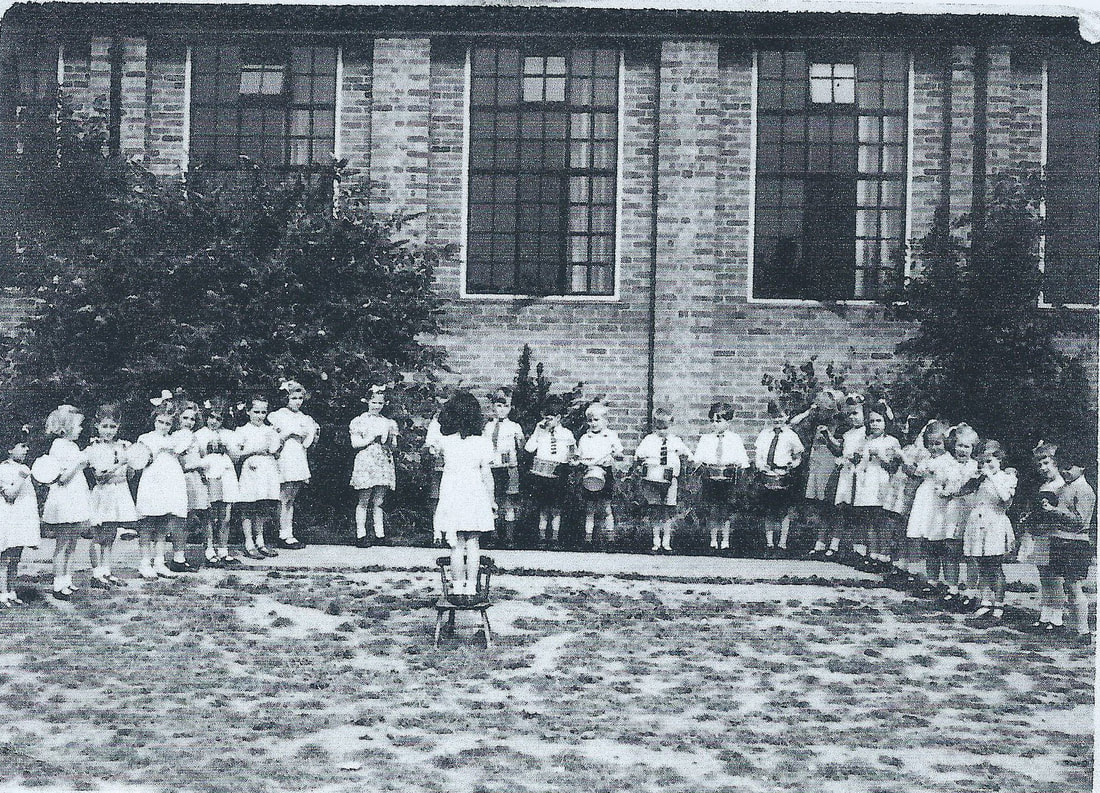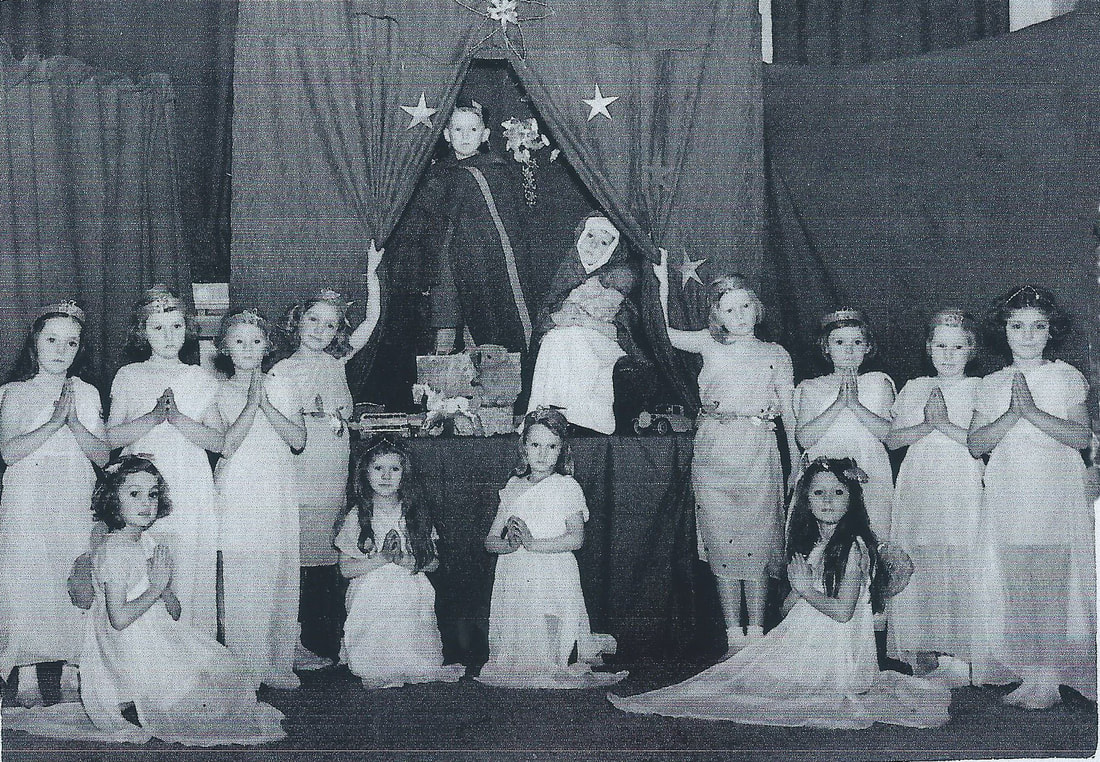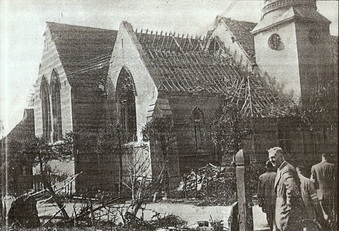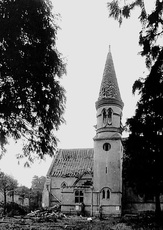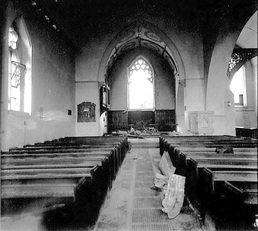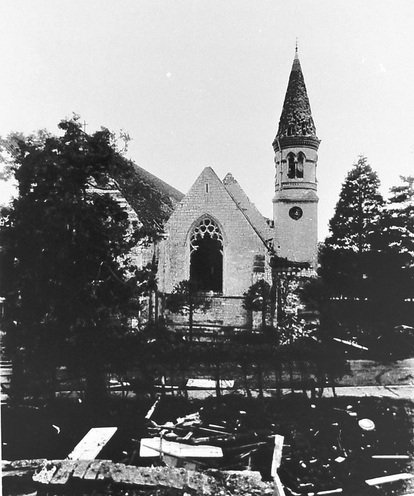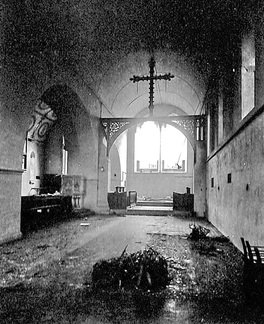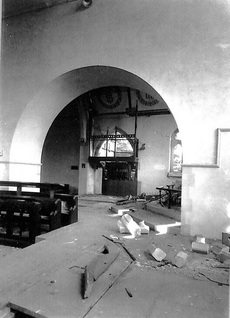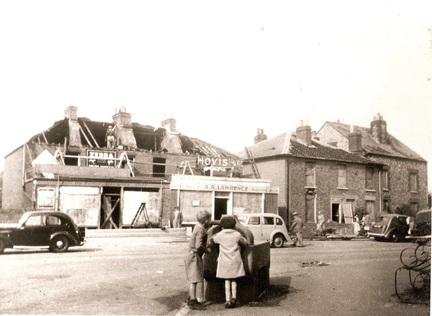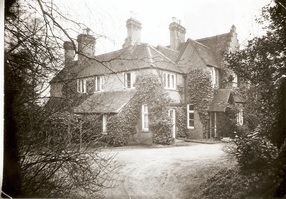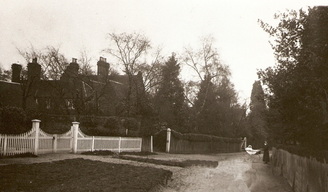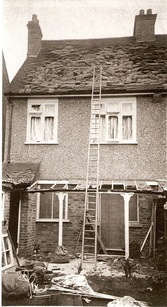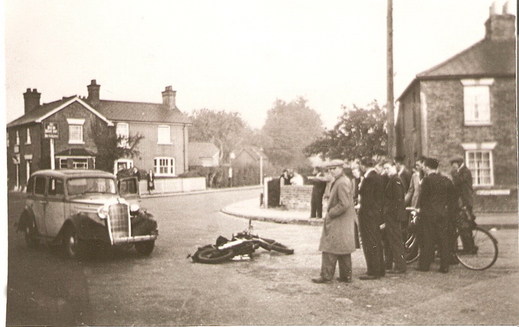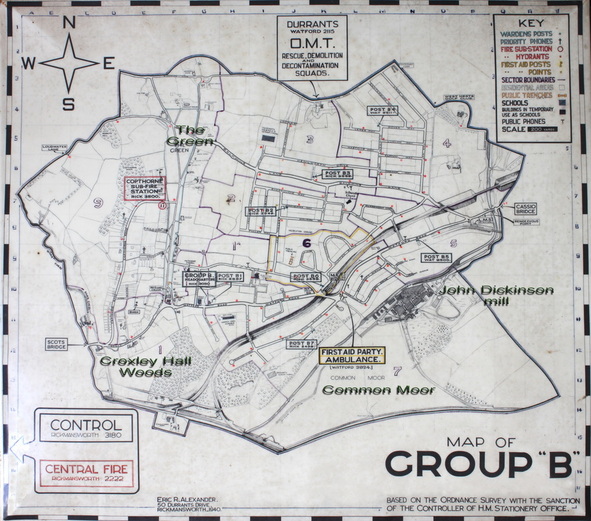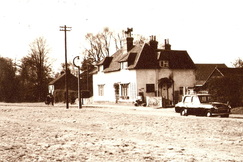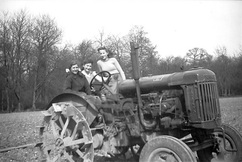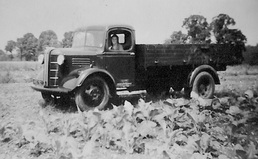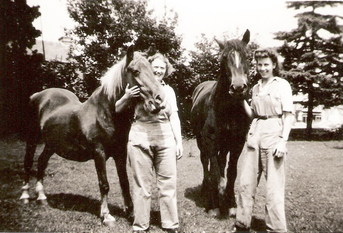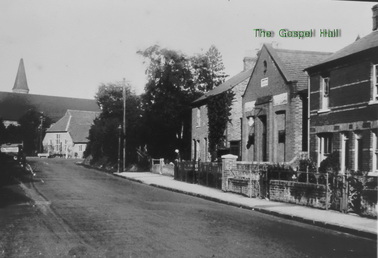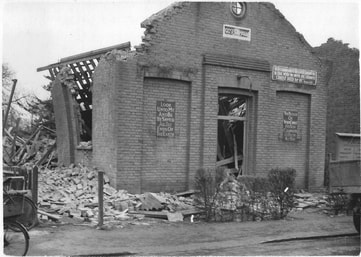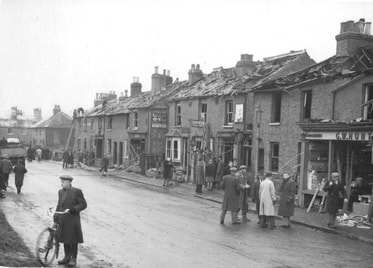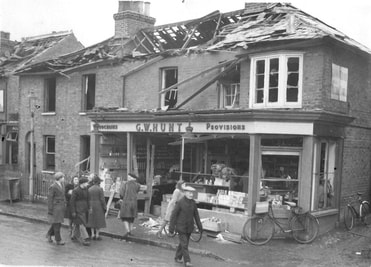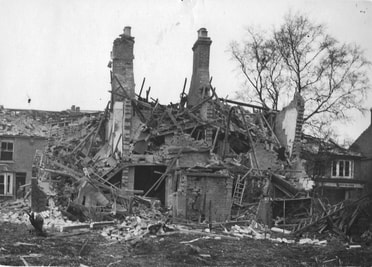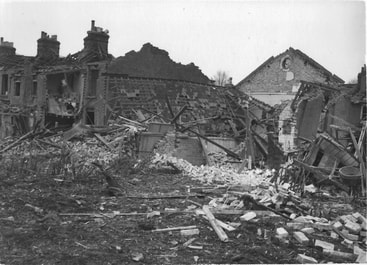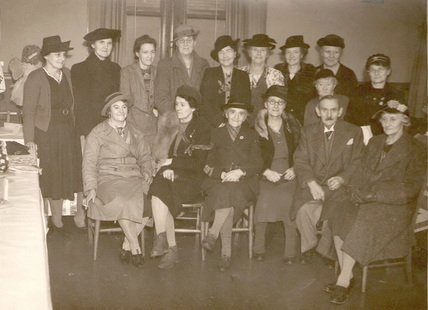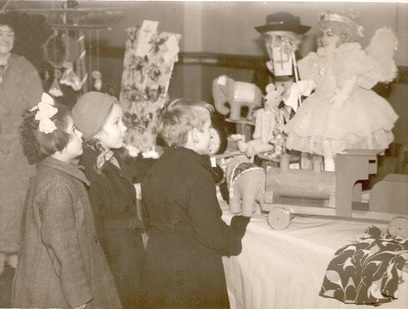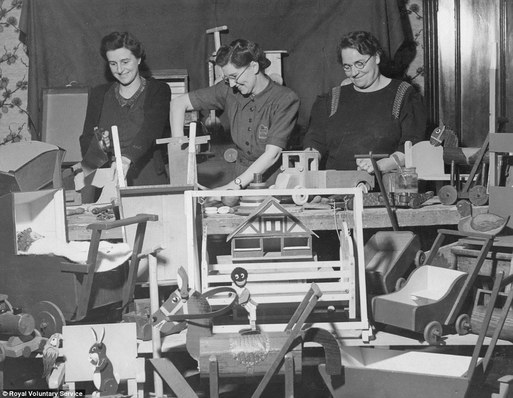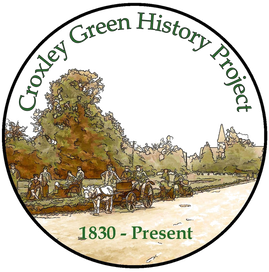The Second World War 1939-1945
The devastation in Europe between1914-1918 and the defeat of the German army resulted in the signing of the Treaty of Versailles in June 1919 and the formation of the League of Nations. It was envisaged that any future international disputes could be sorted out by discussion, avoiding future wars. At the same time war weapon restrictions were imposed on the German armed forces.
Adolf Hitler became Chancellor of Germany in January 1933 and a ‘fascist’ state began to emerge. By October, Hitler had decided to disregard the terms of the Treaty because of Germany’s unequal military power. Hitler trebled the size of the German Army, observing any reaction especially from Britain and France.
Benito Mussolini, the leader of Italy, also a ‘fascist’ state, invaded Ethiopia in October 1935 without any serious political reaction and this led to Hitler invading countries on the German borders.
After failed attempts by Neville Chamberlain, Prime Minister of Britain, to curtail any further tension, the German army invaded Poland.
On Sunday 3rd September 1939, Neville Chamberlain, speaking via a wireless message, informed the Nation that Great Britain was ‘now at war with Germany’.
In Britain, the possibility of war had been recognised some years earlier and in1935 the government, led then by Prime Minister Stanley Baldwin, invited the local authorities to make plans to protect the population in times of war.
In 1924 a committee had been set up known as Air Raid Precautions (ARP) and this organisation had been progressively updated should it be necessary to implement it at short notice. Air raid shelters were the first precautions to be considered and in 1937 the Government created the Air Raid Wardens Service and following a request for volunteers to become Air Raid Precaution Wardens, Sir John Anderson was placed in charge of some 200,000 Wardens in 1938.
During the ensuing year, prior to the massive aerial onslaught that was to come. ARP Wardens were tasked with organising the acquisition of cellars and basements for air raid shelters as well as the construction of community shelters. Trenches were dug in parks and recreation grounds. In Croxley Green public shelters were built at Harvey Road School and Baldwins Lane recreation grounds. Trenches were dug on The Green near All Saints Church as well as in Barton Way recreation ground and also an Emergency Water Supply (EWS) for fire fighting was provided in a substantial water tank. Other temporary shelters were erected throughout the village, sometimes in streets that were considered a safer place than inside homes.
Sir John Anderson commissioned William Patterson, an engineer, to design a cheap shelter that could be erected in gardens and available to families. These were supplied free of charge to poorer families whilst those families earning above a certain amount had to pay. They were referred to as ‘Anderson Shelters’. Residents were advised to put adhesive paper tape on windows as a precaution against bomb blasts.
Adolf Hitler became Chancellor of Germany in January 1933 and a ‘fascist’ state began to emerge. By October, Hitler had decided to disregard the terms of the Treaty because of Germany’s unequal military power. Hitler trebled the size of the German Army, observing any reaction especially from Britain and France.
Benito Mussolini, the leader of Italy, also a ‘fascist’ state, invaded Ethiopia in October 1935 without any serious political reaction and this led to Hitler invading countries on the German borders.
After failed attempts by Neville Chamberlain, Prime Minister of Britain, to curtail any further tension, the German army invaded Poland.
On Sunday 3rd September 1939, Neville Chamberlain, speaking via a wireless message, informed the Nation that Great Britain was ‘now at war with Germany’.
In Britain, the possibility of war had been recognised some years earlier and in1935 the government, led then by Prime Minister Stanley Baldwin, invited the local authorities to make plans to protect the population in times of war.
In 1924 a committee had been set up known as Air Raid Precautions (ARP) and this organisation had been progressively updated should it be necessary to implement it at short notice. Air raid shelters were the first precautions to be considered and in 1937 the Government created the Air Raid Wardens Service and following a request for volunteers to become Air Raid Precaution Wardens, Sir John Anderson was placed in charge of some 200,000 Wardens in 1938.
During the ensuing year, prior to the massive aerial onslaught that was to come. ARP Wardens were tasked with organising the acquisition of cellars and basements for air raid shelters as well as the construction of community shelters. Trenches were dug in parks and recreation grounds. In Croxley Green public shelters were built at Harvey Road School and Baldwins Lane recreation grounds. Trenches were dug on The Green near All Saints Church as well as in Barton Way recreation ground and also an Emergency Water Supply (EWS) for fire fighting was provided in a substantial water tank. Other temporary shelters were erected throughout the village, sometimes in streets that were considered a safer place than inside homes.
Sir John Anderson commissioned William Patterson, an engineer, to design a cheap shelter that could be erected in gardens and available to families. These were supplied free of charge to poorer families whilst those families earning above a certain amount had to pay. They were referred to as ‘Anderson Shelters’. Residents were advised to put adhesive paper tape on windows as a precaution against bomb blasts.
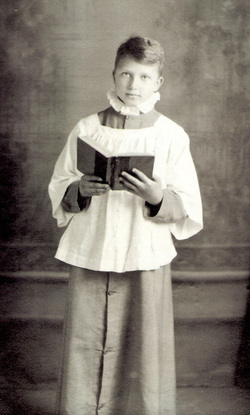 Jim Linwood Choirboy - Click on the picture for more information about Jim
Jim Linwood Choirboy - Click on the picture for more information about Jim
Citizens were recruited into various organisations to supplement the services already provided by the many police forces, fire and ambulance brigade. These included the War Reserve Police, the Auxiliary Fire Service, the Women’s Voluntary Service, Rescue Teams and Firewatchers all known collectively as The Civil Defence Services. Large commercial companies were encouraged to make their own arrangements and John Dickinson’s Croxley Mill reacted accordingly.
Residents, including senior schoolboys, were also recruited as ‘fire watchers’ during the day and night in case of attacks and were given designated location points throughout the village as their ‘watch’.
The government set up a system of local self government based on ‘regions’ should an emergency situation occur throughout the U.K. Each region was sub divided into ‘areas’ where groups/posts were created. Under the Rickmansworth Urban District Council, Rickmansworth, Croxley Green, Moor Park, Mill End and West Hyde were groups/posts of Area ‘D’ which formed part of the Eastern Region.
If the scheme was activated, each region would assume responsibility for its own internal transport, feeding arrangements and supply of fuel and power together with the supply and movement of labour.
The National Registration exercise of 29th September 1939 resulted in the issue of a personal identity card and ration book for each citizen. The rationing of basic food items commenced in January 1940. Citizens had to register with their preferred local supplier who was then allocated quantities of supplies. Eventually, rationing was extended to include most food items plus clothing and furniture.
It so happened that relevant shops in Croxley Green were conveniently located to serve the residents. Very little could be obtained without surrender of the necessary coupon(s) from a person’s ration book. Each book was a different colour according to each individual’s requirements, with most adults having a buff-coloured one.
Pregnant women or nursing mothers and children under five had green books and were given priority for fruit, a daily pint of milk and a double supply of eggs (if available). This also applied to children between five and sixteen who had blue books.
The issuing of ration books was intended to overcome rising prices, hoarding and be a fairer way of sharing food. However, there was a perception that eggs, butter and meat could be obtained fairly easily without coupons in rural areas whereas in towns and cities these commodities were less readily available.
Later, in 1940, everyone was issued with a personal gas mask each in its own cardboard box, as it was considered an impending threat that Germany would drop poisonous gas canisters on the civilian population. Citizens were advised to carry their gas mask and their identity cards at all times.
Qualified chemists were recruited into what were known ‘Gas Identification Squads’ and were tasked with being alert to the possibility of poison gas attacks.
Post Office pillar box caps as well as specially provided wooden boards were erected and were painted with a yellowish green paint that would react in the event of a gas attack, enabling Air Raid Wardens to sound the alert. The alert in some areas would be sounded by the use of wooden rattles of the type used by football supporters.
Some male residents of Croxley Green who were either over 40 years or under 18 years joined the newly formed Local Defence Volunteers (LDV) later renamed the Home Guard by Winston Churchill. They were part of the Hertfordshire 8th Battalion and their headquarters was in Croxley House. Initially provided with ‘broomsticks’ in lieu of rifles they could often be seen on Common Moor performing military exercises. This was also an area used by John Dickinson’s Mill own Home Guard volunteers practising on a regular basis.
The evacuation of school children, teachers, parent’s with children under school age and expectant mothers from London saw the arrival of many new faces in Croxley Green. The government requested Local Authorities should be assisted by the Women’s Voluntary Service (WVS), Women’s Institute (WI) and members of the Girl Guides (where available) to carry out the reception and billeting arrangements.
Luggage labels were attached to children with all the necessary details so they would not be misplaced or lost. They carried a small case or possibly a home made kit bag containing a child’s gas mask, a change of underwear, night wear, house shoes or plimsoles, spare stockings or socks, toothbrush, comb, towel, soap and face cloth, handkerchiefs and a warm coat. In most cases they were also asked to take a packet of food for the day’s travelling.
Residents were asked to accept strangers into their homes for an unspecified time for a payment of ten shillings & sixpence for one child or eight shillings & sixpence each if there was more than one. The transition was not always easy for the participants. Over 600 evacuee children from the London schools initially had to be accommodated and the influx of so many children put considerable strain on the already stretched education facilities in Croxley Green.
Harvey Road School and Durrants School, both new to Croxley Green, were used as distributing depots for the evacuees. Volunteers were first asked to submit their names to Mrs. Bell at Overdale, Copthorne Road, then asked to escort small parties from the depots to their ‘temporary billets’.
All available public buildings including the Guildhouse and the hall at the rear, as well as the Methodist Hall, became school accommodation. All Saints Church Hall was used by St Sepulchre’s Church School, Holborn, (all four classes in the same room, each occupying a corner of the room, their work balanced on their knees for writing etc).
Evacuees from the parish of St Albans, Holborn as well as the headmistress and school of All Souls’ Langham Place, were allocated St Oswald’s Church Hall. The headmistress also became the choir mistress of the church and created a magnificent choir.
As the children’s education progressed through Yorke Road, Watford Road Boys and the newly built Durrants Senior School and Harvey Road School every child was given the same opportunity to attend the grammar schools in Watford should they pass the appropriate examination.
Residents, including senior schoolboys, were also recruited as ‘fire watchers’ during the day and night in case of attacks and were given designated location points throughout the village as their ‘watch’.
The government set up a system of local self government based on ‘regions’ should an emergency situation occur throughout the U.K. Each region was sub divided into ‘areas’ where groups/posts were created. Under the Rickmansworth Urban District Council, Rickmansworth, Croxley Green, Moor Park, Mill End and West Hyde were groups/posts of Area ‘D’ which formed part of the Eastern Region.
If the scheme was activated, each region would assume responsibility for its own internal transport, feeding arrangements and supply of fuel and power together with the supply and movement of labour.
The National Registration exercise of 29th September 1939 resulted in the issue of a personal identity card and ration book for each citizen. The rationing of basic food items commenced in January 1940. Citizens had to register with their preferred local supplier who was then allocated quantities of supplies. Eventually, rationing was extended to include most food items plus clothing and furniture.
It so happened that relevant shops in Croxley Green were conveniently located to serve the residents. Very little could be obtained without surrender of the necessary coupon(s) from a person’s ration book. Each book was a different colour according to each individual’s requirements, with most adults having a buff-coloured one.
Pregnant women or nursing mothers and children under five had green books and were given priority for fruit, a daily pint of milk and a double supply of eggs (if available). This also applied to children between five and sixteen who had blue books.
The issuing of ration books was intended to overcome rising prices, hoarding and be a fairer way of sharing food. However, there was a perception that eggs, butter and meat could be obtained fairly easily without coupons in rural areas whereas in towns and cities these commodities were less readily available.
Later, in 1940, everyone was issued with a personal gas mask each in its own cardboard box, as it was considered an impending threat that Germany would drop poisonous gas canisters on the civilian population. Citizens were advised to carry their gas mask and their identity cards at all times.
Qualified chemists were recruited into what were known ‘Gas Identification Squads’ and were tasked with being alert to the possibility of poison gas attacks.
Post Office pillar box caps as well as specially provided wooden boards were erected and were painted with a yellowish green paint that would react in the event of a gas attack, enabling Air Raid Wardens to sound the alert. The alert in some areas would be sounded by the use of wooden rattles of the type used by football supporters.
Some male residents of Croxley Green who were either over 40 years or under 18 years joined the newly formed Local Defence Volunteers (LDV) later renamed the Home Guard by Winston Churchill. They were part of the Hertfordshire 8th Battalion and their headquarters was in Croxley House. Initially provided with ‘broomsticks’ in lieu of rifles they could often be seen on Common Moor performing military exercises. This was also an area used by John Dickinson’s Mill own Home Guard volunteers practising on a regular basis.
The evacuation of school children, teachers, parent’s with children under school age and expectant mothers from London saw the arrival of many new faces in Croxley Green. The government requested Local Authorities should be assisted by the Women’s Voluntary Service (WVS), Women’s Institute (WI) and members of the Girl Guides (where available) to carry out the reception and billeting arrangements.
Luggage labels were attached to children with all the necessary details so they would not be misplaced or lost. They carried a small case or possibly a home made kit bag containing a child’s gas mask, a change of underwear, night wear, house shoes or plimsoles, spare stockings or socks, toothbrush, comb, towel, soap and face cloth, handkerchiefs and a warm coat. In most cases they were also asked to take a packet of food for the day’s travelling.
Residents were asked to accept strangers into their homes for an unspecified time for a payment of ten shillings & sixpence for one child or eight shillings & sixpence each if there was more than one. The transition was not always easy for the participants. Over 600 evacuee children from the London schools initially had to be accommodated and the influx of so many children put considerable strain on the already stretched education facilities in Croxley Green.
Harvey Road School and Durrants School, both new to Croxley Green, were used as distributing depots for the evacuees. Volunteers were first asked to submit their names to Mrs. Bell at Overdale, Copthorne Road, then asked to escort small parties from the depots to their ‘temporary billets’.
All available public buildings including the Guildhouse and the hall at the rear, as well as the Methodist Hall, became school accommodation. All Saints Church Hall was used by St Sepulchre’s Church School, Holborn, (all four classes in the same room, each occupying a corner of the room, their work balanced on their knees for writing etc).
Evacuees from the parish of St Albans, Holborn as well as the headmistress and school of All Souls’ Langham Place, were allocated St Oswald’s Church Hall. The headmistress also became the choir mistress of the church and created a magnificent choir.
As the children’s education progressed through Yorke Road, Watford Road Boys and the newly built Durrants Senior School and Harvey Road School every child was given the same opportunity to attend the grammar schools in Watford should they pass the appropriate examination.
The German air force launched its attacks on England on the 12th August 1940 and Croxley Green was to experience many air-raid alerts within Area D: twenty-seven were sounded between 19th and 31st August.
In September that year, during ‘The Battle of Britain’, many dog fights (aerial combat fighter aircraft at short range) were witnessed in Area D and the sirens sounded 110 times. One particular alert lasted 10hrs 15 minutes.
Throughout the period and after, Croxley Green and its residents suffered a number of incidents involving damage and injuries when high explosive bombs and oil bombs fell.
An anti-aircraft shell exploded behind the houses on the west side of Copthorne Road and a high explosive bomb fell near Rousebarn Lane.
During the night of the 25th September, on the 93rd alert of the month, two parachute mines fell and exploded near All Saints Church. No one was killed but seven of the thirteen casualties required hospital treatment.
The massive explosions caused considerable damage to the church, church hall and other property. Eight houses were destroyed and three hundred and fifty eight sustained damage. A mile away in Rickmansworth at 80, High Street the shop window of ‘The Fifty Shilling Tailors ’was broken by the blast.
In September that year, during ‘The Battle of Britain’, many dog fights (aerial combat fighter aircraft at short range) were witnessed in Area D and the sirens sounded 110 times. One particular alert lasted 10hrs 15 minutes.
Throughout the period and after, Croxley Green and its residents suffered a number of incidents involving damage and injuries when high explosive bombs and oil bombs fell.
An anti-aircraft shell exploded behind the houses on the west side of Copthorne Road and a high explosive bomb fell near Rousebarn Lane.
During the night of the 25th September, on the 93rd alert of the month, two parachute mines fell and exploded near All Saints Church. No one was killed but seven of the thirteen casualties required hospital treatment.
The massive explosions caused considerable damage to the church, church hall and other property. Eight houses were destroyed and three hundred and fifty eight sustained damage. A mile away in Rickmansworth at 80, High Street the shop window of ‘The Fifty Shilling Tailors ’was broken by the blast.
On the 29th September an oil bomb and two high explosive bombs destroyed seven houses and damaged two others near to the Metropolitan Railway station, but no one was hurt. It was witnessed that an oil bomb landed in a garden well.
In October, there were one hundred and eleven ‘alerts’ in Area D, with one lasting over twelve hours. Incendiary bombs fell on Common Moor, Lincoln Way, Rochester Way and Winchester Crescent.
A map of Croxley Green was produced to show the disposition of their Civil Defence arrangements. Croxley Green, as ‘B Section’ of Area D, was sub-divided into a number of areas and had strategically placed ‘posts’ with a local resident as warden and given the responsibility for each assigned numbered area. They included. B1 ‘Old Boys School’ Watford Road (Head Quarters), B2 Winchester Way, B3 The Avenue (between Baldwins Lane and Kennelworth Drive), B4 Durrants Drive (opposite Dover Way), B5 Watford Road (entrance to what is now Sycamore Approach), B6 Winton Drive (near Metropolitan Station), B7 Frankland Road.
Private homes with a telephone were made available for emergencies. These were in Copthorne Road, Green Lane, Beechcroft Avenue, Highfield House (off Scots Hill now demolished) and The Green (opposite All Saints Church) as well as five public telephone boxes around the village that were marked on the map.
Two trenches were dug for emergency use in case of an air raid, on The Green close to All Saints Church and in Barton Way recreation ground.
Buildings were identified for use as temporary schools at Dickinson Guildhall, St Oswald’s Church Hall, Methodist Chapel, All Saints Church Hall and the Scout Hall in the Watford Road.
Durrants House (then Old Merchant Tailors) became the Headquarters for the Rescue, Demolition and Decontaminations Squads should they be required and a First Aid post was created at the top of Mill Lane.
Locations of water hydrants were identified for emergency use and in excess of sixty were identified throughout the village. The knowledge of these locations was invaluable to the firemen who were stationed at the sub fire station in Copthorne Road (opposite the entrance gates to Copthorne House)
The map also showed a warning siren at the windmill off The Green.
A map of Croxley Green was produced to show the disposition of their Civil Defence arrangements. Croxley Green, as ‘B Section’ of Area D, was sub-divided into a number of areas and had strategically placed ‘posts’ with a local resident as warden and given the responsibility for each assigned numbered area. They included. B1 ‘Old Boys School’ Watford Road (Head Quarters), B2 Winchester Way, B3 The Avenue (between Baldwins Lane and Kennelworth Drive), B4 Durrants Drive (opposite Dover Way), B5 Watford Road (entrance to what is now Sycamore Approach), B6 Winton Drive (near Metropolitan Station), B7 Frankland Road.
Private homes with a telephone were made available for emergencies. These were in Copthorne Road, Green Lane, Beechcroft Avenue, Highfield House (off Scots Hill now demolished) and The Green (opposite All Saints Church) as well as five public telephone boxes around the village that were marked on the map.
Two trenches were dug for emergency use in case of an air raid, on The Green close to All Saints Church and in Barton Way recreation ground.
Buildings were identified for use as temporary schools at Dickinson Guildhall, St Oswald’s Church Hall, Methodist Chapel, All Saints Church Hall and the Scout Hall in the Watford Road.
Durrants House (then Old Merchant Tailors) became the Headquarters for the Rescue, Demolition and Decontaminations Squads should they be required and a First Aid post was created at the top of Mill Lane.
Locations of water hydrants were identified for emergency use and in excess of sixty were identified throughout the village. The knowledge of these locations was invaluable to the firemen who were stationed at the sub fire station in Copthorne Road (opposite the entrance gates to Copthorne House)
The map also showed a warning siren at the windmill off The Green.
As war broke out the Emergency Services began to appeal for volunteers to cover many aspects defending the countryside, towns and villages and was the responsibility of the Local Authority. Initially very little equipment and uniforms were available and ‘make do’ was the best on offer. This has been particularly highlighted with the Home Guard, originally called the Local Defence Volunteers and because many were passed uniformed men from WW1 and (some) advanced in years were humorously called ‘Dad’s Army’ However, LDV was changed to Home Guard and were to become a valuable asset and ready for action if required. Training was given depending on past experience to all the groups.
Croxley Green area map shows all the emergency service location- some still recognisable. A fire station at The Green end of Copthorne Road can still be seen but ‘change of use’ The First Aid Unit was at the top of Mill Lane near Frankland Road and now shops.
Croxley Green area map shows all the emergency service location- some still recognisable. A fire station at The Green end of Copthorne Road can still be seen but ‘change of use’ The First Aid Unit was at the top of Mill Lane near Frankland Road and now shops.
Fears were very real that Britain would be invaded by the German Army, so much so that all road signs indicating the locations of towns and villages were removed to impede their troop movements. Railway station signs too were removed, as were directional ‘finger posts’ on all main and country roads. These were stored away for the next couple of years until it was considered that the German army was not intending an imminent invasion by land and then they were gradually reinstated. However, bombing raids continued on British cities, but for Croxley Green the remainder of the year appeared relatively quiet except for an incident when an AA bomb fell in a garden in Baldwins Lane.
Although the air-raid alert in Croxley Green was often sounded in the years after the Battle of Britain there were few reported incidents of air attack or damage.
The heavy bombing of major cities during the autumn of 1940 began to impact on food supplies and the intention was to starve the people of Britain into surrendering. German ‘U’ boat submarines began attacking merchant ships bringing food supplies from the USA and Canada.
The government made every effort to ensure the population was adequately fed as many people with war related jobs were constantly on the move. Local councils were provided with plans to establish ‘Community Feeding Centres’ (soon to be called ‘British Restaurants’ by Winston Churchill). They could be prefabricated buildings built on vacant sites or existing buildings converted into a suitable venue and the councils were encouraged to make the interior as attractive as possible and initially operated a self-service scheme.
Loans to assist with the finance were provided and Croxley Green’s British Restaurant was situated close to Winton Drive/Winton Crescent. The required provision was at least 100 adequate meals at one sitting.
Owing to the shortage of food, producing appetising and varied meals was initially limited, but for the British nation it would appear complaining was not on the menu!
Where possible, citizens were encouraged to ‘Dig for Victory’ and many private gardens became vegetable plots. Land was made available for extra allotments including a large area off All Saints Lane, now playing fields for Rickmansworth School, and vacant land around St Oswald’s church hall where members of the congregation could rent plots.
Many people took to rearing chickens and ducks both for eggs as well as for their meat. Food waste was collected for ‘pig swill’ and pig clubs were set up, feeding the pigs on these kitchen scraps and sharing the pork when the pigs were slaughtered.
Much of the agricultural production work in the area was carried out by the Women’s Land Army which was drafted in to help farmers on the land. Typically, Nabby Sears who had a farm/farmhouse on The Green (now Whitegates Close) found his ‘girls’ an invaluable help performing many of the routine jobs and they could regularly be seen ploughing in fields near the Sarratt lanes or herding his cows across The Green to the milking sheds at the top of Scots Hill.
Although the air-raid alert in Croxley Green was often sounded in the years after the Battle of Britain there were few reported incidents of air attack or damage.
The heavy bombing of major cities during the autumn of 1940 began to impact on food supplies and the intention was to starve the people of Britain into surrendering. German ‘U’ boat submarines began attacking merchant ships bringing food supplies from the USA and Canada.
The government made every effort to ensure the population was adequately fed as many people with war related jobs were constantly on the move. Local councils were provided with plans to establish ‘Community Feeding Centres’ (soon to be called ‘British Restaurants’ by Winston Churchill). They could be prefabricated buildings built on vacant sites or existing buildings converted into a suitable venue and the councils were encouraged to make the interior as attractive as possible and initially operated a self-service scheme.
Loans to assist with the finance were provided and Croxley Green’s British Restaurant was situated close to Winton Drive/Winton Crescent. The required provision was at least 100 adequate meals at one sitting.
Owing to the shortage of food, producing appetising and varied meals was initially limited, but for the British nation it would appear complaining was not on the menu!
Where possible, citizens were encouraged to ‘Dig for Victory’ and many private gardens became vegetable plots. Land was made available for extra allotments including a large area off All Saints Lane, now playing fields for Rickmansworth School, and vacant land around St Oswald’s church hall where members of the congregation could rent plots.
Many people took to rearing chickens and ducks both for eggs as well as for their meat. Food waste was collected for ‘pig swill’ and pig clubs were set up, feeding the pigs on these kitchen scraps and sharing the pork when the pigs were slaughtered.
Much of the agricultural production work in the area was carried out by the Women’s Land Army which was drafted in to help farmers on the land. Typically, Nabby Sears who had a farm/farmhouse on The Green (now Whitegates Close) found his ‘girls’ an invaluable help performing many of the routine jobs and they could regularly be seen ploughing in fields near the Sarratt lanes or herding his cows across The Green to the milking sheds at the top of Scots Hill.
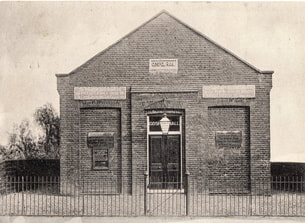 The Gospel Hall soon after it was built
The Gospel Hall soon after it was built
In response to appeals for scrap metal to support the ‘war effort’, residents throughout the area provided unwanted cooking utensils and other household implements for recycling into military equipment. The metal railings were removed from outside many residents’ homes and commercial buildings as well as the original cattle guards from around the commemorative trees and the First World War Memorial on the Green.
Intentions to remove metal fencing and the gates enclosing the Dickinson sports field were thwarted by protests from mothers concerned for the safety of children attending the sports pavilion requisitioned as a children’s nursery. Mothers threatened to give up their voluntary work and stay at home if they were removed. A series of letters to the authorities expressed the seriousness of their intent, but a lady official from the Ministry gave them her assurance that the gates and fences would remain
Troops and military equipment that was being transferred across the country was often seen travelling through Croxley Green sometimes struggling up Scots Hill, which was not a dual carriageway in those days.
To promote the use of foods that people were less used to harvesting and preparing, recipes for the free food found in the countryside were published. Housewives were advised to make jams, chutneys and pickles to ensure that ‘good-tasting foods in the home were offered through the wintertime’. Preserves were made from a wide variety of produce including onions and rosehips.
Walter Stone of ‘Stones Orchard’ on The Green would have been a valuable source of fresh fruit during the summer and autumn time and with the area prolific with watercress beds owned by the Sansom and Dorrofield families local residents could supplement their rations. Local farms were encouraged to increase their output.
In March 1941 Ellen Wilkinson was made responsible for another type of air raid shelter and was instrumental in the introduction of the Morrison shelter named after the Home Secretary, Herbert Morrison. The shelters were made of very heavy steel and could be put in the living room and used as a table. One wire side lifted up for people to crawl underneath and get inside. They were fairly large, providing sleeping space for two or three people.
John Dickinson Company at Croxley Mill changed its usual output of paper to board that was required to make fuse-caps for ammunition as well as producing specialist paper required in the ‘war effort’. The Croxley Mill was also recognised as a ‘nucleus’ firm in the paper industry and ‘engaged on work of an important national character’.
Employees were also granted the choice of staying employed as a ‘reserved occupation’ so that they did not have to enroll in the Armed Services and were exempt from ‘call up’ unless they chose to enlist.
On the other side of the world, Japanese forces attacked the United States of America’s fleet in Pearl Harbour on the 7th December1941. This was to set off major conflict throughout most of the world.
From July 1942 householders registered with a specific milkman who delivered the milk from a local farm. There were times when fresh milk was not always available in the quantity that most families would prefer. Extra supplies of ‘dried’ milk could be obtained in canisters labelled ‘Nation Dried Milk’. The powder once reconstituted with water was suitable for making cakes and puddings but was not recommended as a cold drink!
Croxley Green was on the Grand Union Canal and narrow boats were now given a high profile for the delivery and transportation of goods up and down this once busy transport system, as it was considered a safer means of transport and less targeted than the railways which were often under attack by the German Luftwaffe.
Although residents and the many organisations had to remain vigilant at this time of grim shortages, and despite the personal tragedy of loved ones being killed on active duty, there remained a sense of neighbourliness and good humour under these very trying conditions. Croxley Green was not seriously affected again until 1944 when the German army stepped up their attacks.
New threats were the German V1 ‘Doodle Bugs’, pilotless missiles that were launched from France with enough fuel to get them across the Channel to targeted areas. They would fall to earth and explode with vast amounts of ammunition. They had a devastating effect as the noise that they made was quite distinct and when this stopped the missile was certain to fall causing great alarm among residents.
These missiles were sometimes heard going over Croxley Green skies heading for their designated target.
After this destructive and alarming new method of attack, the German army soon produced even more horrific attacks with V2 Rockets. These rockets could reach their targets at longer ranges and were so frightening because there was no pre-warning. These were mostly aimed towards larger cities with the aim of causing wider destruction of property and killing more civilians.
On the night of February 19th 1944 another parachute bomb fell near Scots Hill almost 150yds from where the parachute mine had fallen in 1940. The bomb exploded on an outhouse causing 25 casualties of which 7 were serious but none fatal. The blast affected 210 houses and 7, including the Gospel Hall, were demolished.
Intentions to remove metal fencing and the gates enclosing the Dickinson sports field were thwarted by protests from mothers concerned for the safety of children attending the sports pavilion requisitioned as a children’s nursery. Mothers threatened to give up their voluntary work and stay at home if they were removed. A series of letters to the authorities expressed the seriousness of their intent, but a lady official from the Ministry gave them her assurance that the gates and fences would remain
Troops and military equipment that was being transferred across the country was often seen travelling through Croxley Green sometimes struggling up Scots Hill, which was not a dual carriageway in those days.
To promote the use of foods that people were less used to harvesting and preparing, recipes for the free food found in the countryside were published. Housewives were advised to make jams, chutneys and pickles to ensure that ‘good-tasting foods in the home were offered through the wintertime’. Preserves were made from a wide variety of produce including onions and rosehips.
Walter Stone of ‘Stones Orchard’ on The Green would have been a valuable source of fresh fruit during the summer and autumn time and with the area prolific with watercress beds owned by the Sansom and Dorrofield families local residents could supplement their rations. Local farms were encouraged to increase their output.
In March 1941 Ellen Wilkinson was made responsible for another type of air raid shelter and was instrumental in the introduction of the Morrison shelter named after the Home Secretary, Herbert Morrison. The shelters were made of very heavy steel and could be put in the living room and used as a table. One wire side lifted up for people to crawl underneath and get inside. They were fairly large, providing sleeping space for two or three people.
John Dickinson Company at Croxley Mill changed its usual output of paper to board that was required to make fuse-caps for ammunition as well as producing specialist paper required in the ‘war effort’. The Croxley Mill was also recognised as a ‘nucleus’ firm in the paper industry and ‘engaged on work of an important national character’.
Employees were also granted the choice of staying employed as a ‘reserved occupation’ so that they did not have to enroll in the Armed Services and were exempt from ‘call up’ unless they chose to enlist.
On the other side of the world, Japanese forces attacked the United States of America’s fleet in Pearl Harbour on the 7th December1941. This was to set off major conflict throughout most of the world.
From July 1942 householders registered with a specific milkman who delivered the milk from a local farm. There were times when fresh milk was not always available in the quantity that most families would prefer. Extra supplies of ‘dried’ milk could be obtained in canisters labelled ‘Nation Dried Milk’. The powder once reconstituted with water was suitable for making cakes and puddings but was not recommended as a cold drink!
Croxley Green was on the Grand Union Canal and narrow boats were now given a high profile for the delivery and transportation of goods up and down this once busy transport system, as it was considered a safer means of transport and less targeted than the railways which were often under attack by the German Luftwaffe.
Although residents and the many organisations had to remain vigilant at this time of grim shortages, and despite the personal tragedy of loved ones being killed on active duty, there remained a sense of neighbourliness and good humour under these very trying conditions. Croxley Green was not seriously affected again until 1944 when the German army stepped up their attacks.
New threats were the German V1 ‘Doodle Bugs’, pilotless missiles that were launched from France with enough fuel to get them across the Channel to targeted areas. They would fall to earth and explode with vast amounts of ammunition. They had a devastating effect as the noise that they made was quite distinct and when this stopped the missile was certain to fall causing great alarm among residents.
These missiles were sometimes heard going over Croxley Green skies heading for their designated target.
After this destructive and alarming new method of attack, the German army soon produced even more horrific attacks with V2 Rockets. These rockets could reach their targets at longer ranges and were so frightening because there was no pre-warning. These were mostly aimed towards larger cities with the aim of causing wider destruction of property and killing more civilians.
On the night of February 19th 1944 another parachute bomb fell near Scots Hill almost 150yds from where the parachute mine had fallen in 1940. The bomb exploded on an outhouse causing 25 casualties of which 7 were serious but none fatal. The blast affected 210 houses and 7, including the Gospel Hall, were demolished.
In early1945 the Allied Forces had advanced into Europe and retaken much of the land once occupied by the German army.
By May 7th 1945 senior members of the German army had surrendered and hostilities ceased and on the following day, May 8th,peace was declared.
Towns and cities across Britain began to celebrate with street parties, despite the lack of resources. Croxley Green residents did this on a grand scale and each party took on its own organised event in style.
However, America was still at war with Japan and made a decision to drop an atom bomb on the city of Hiroshima on the 6th August 1945 and a second one on Nagasaki on the 9th August. This act and the horrific consequences brought about the Japanese surrender on 2nd September.
It was not until the end of December 1945 that the Home Guard was disbanded and as it took many years for the UK to recover, residents were still being encouraged to continue to grow fruit and vegetables. Though essential commodities were gradually made available once more, it was not until July 1954 that food rationing was finally removed.
By May 7th 1945 senior members of the German army had surrendered and hostilities ceased and on the following day, May 8th,peace was declared.
Towns and cities across Britain began to celebrate with street parties, despite the lack of resources. Croxley Green residents did this on a grand scale and each party took on its own organised event in style.
However, America was still at war with Japan and made a decision to drop an atom bomb on the city of Hiroshima on the 6th August 1945 and a second one on Nagasaki on the 9th August. This act and the horrific consequences brought about the Japanese surrender on 2nd September.
It was not until the end of December 1945 that the Home Guard was disbanded and as it took many years for the UK to recover, residents were still being encouraged to continue to grow fruit and vegetables. Though essential commodities were gradually made available once more, it was not until July 1954 that food rationing was finally removed.
It would appear many groups/schools organised events to raise money to help with 'the war effort' These two photographs are examples and show ladies from the Red Cross with organiser Mr.Wilbee in the Guildhouse and children viewing part of the exhibition.
